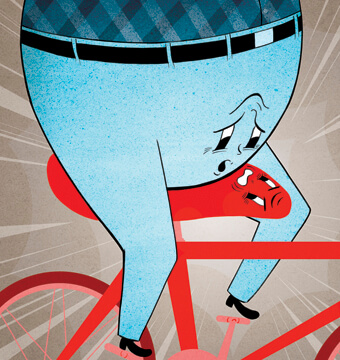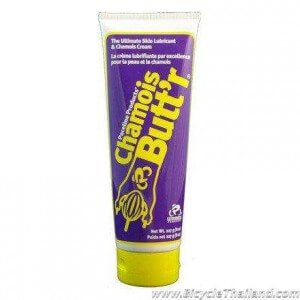Article by Fred Matheny
 A saddle sore can ruin a ride. Even a tiny zit can begin to feel like you’re perched on a golf ball. Nearly as painful are crotch abrasions caused by shorts that bunch or have an irritating seam.
A saddle sore can ruin a ride. Even a tiny zit can begin to feel like you’re perched on a golf ball. Nearly as painful are crotch abrasions caused by shorts that bunch or have an irritating seam.
Even the pros, hardened by thousands of miles in the saddle, fall victim to what cycling author Arnie Baker, M.D., calls “crotchitis.” Fabled tough guys like Eddy Merckx and Sean Kelly had to abandon races when the pain became too great.
Most medical experts say that saddle sores are actually boils caused by skin bacteria that invade surface abrasions. Remedies have come a long way from the era when riders would put slabs of raw steak in their shorts to cushion the abraded area. Of course, avoiding saddle sores is better than curing them (or ruining a good sirloin).
Here’s how:
- Improve your bike fit. If your seat is too high, your hips rock on each pedal stroke and strum your soft tissue across the nose of the saddle. The result is irritated skin and a greater chance of infection. Especially if you suffer from chronic saddle sores, have your position checked by an experienced coach or knowledgeable bike shop person.
- Stand frequently. Doing so takes pressure off your crotch and restores circulation. Get in the habit of standing for 15-20 seconds every few minutes. Use natural opportunities such as short hills, rough pavement or accelerating from stop signs. Stand and stretch when you’re at the back of a paceline or group.
- Move on the saddle. Sit mostly toward the rear where your sit bones get maximum support and take pressure off your crotch. But also move farther back on seated climbs, and more to the middle when bending low to make good time. Each shift relieves pressure points.
- Choose a smooth chamois. Look for shorts with a one-piece liner or one that’s sewn with flat seams. It may take experimenting with shorts brands or chamois types to find the model that works best. Women often do better with shorts designed specifically for their anatomy and that have a liner with no center seam. See “How to Choose Cycling Shorts.”
- Select a supportive seat. Saddle choice is crucial. Excessively wide saddles rub your inner thighs. Narrow saddles don’t provide enough support for your sit bones — your weight is borne by soft tissue that can quickly become bruised and irritated. Thickly padded saddles can press upward between your sit bones, causing uncomfortable numbing pressure. The best choice for any individual rider can only be found through trial and error. Hopefully, your bike shop will have a saddle test-ride program or liberal trade-in policy. See “How to Select a Bicycle Saddle.”
- Lube to reduce friction. To prevent the chamois from abrading skin, apply lubrication before each ride. Try a commercial product such as Chamois BUTT’r or Bag Balm, or simply a light coating of petroleum jelly. Apply a dab the size of a nickel to your crotch before putting on your shorts.
- Keep clean. Always wear clean shorts for each ride. If you seem susceptible to saddle sores, you may find it helpful to wash your crotch with antibacterial soap and warm water before lubing up. Dry your skin well first.
- Strip quickly. After a ride, get out of your sweaty, germy shorts as soon as possible. The environment down there breeds bacteria and encourages them to enter abraded skin. Then shower or clean up with soap and water. Dry well and put on loose-fitting clothing that allows your skin to breathe. For underwear, try boxer shorts. The tight leg bands of briefs cut across the junction of your glutes and hamstrings, right where many saddle sores develop.
- Sleep in the buff. It keeps your crotch dry and free of clothing contact for as long as you’re in bed.
If You Get a Saddle Sore
- Medicate it. Besides keeping it clean, treat it with an over-the-counter acne gel containing 10% benzoyl peroxide. Perhaps even more effective is the topical prescription product called Emgel (erythromycin). If a sore is getting out of control, ask your doctor about a course of oral antibiotics.
- Rest it. As you medicate a troublesome sore, take some time off the bike to help it heal. It’s far better to lose three days now than a week or more after infection sets in. If you continue to ride on an open sore it may eventually form a cyst that requires surgery.
If You Must Continue Riding
Sometimes you can’t take time off. For instance, you may be on a tour or at a cycling camp.
- Change your shorts or saddle. Your problems are probably isolated in one small area — a boil or abrasion. Changing your saddle and/or shorts can reduce pressure on the sore and lessen pain.
- Use a heavier lube. If you’re getting irritated, apply extra lube or switch to a more viscous one. Many long-distance riders swear by Bag Balm, which was originally made for sore cow udders but is now available in most pharmacies.
- Numb it. Over-the-counter pain reducers and anti-inflammatories, such as ibuprofen, can help. In extreme cases, pro team physicians will use a topical anesthetic on riders so they can finish a stage race. It’s not recommended for recreational riders because when you’re numb, you can ride yourself into greater damage.
- Try Preparation H ointment. Prep H works on saddle sores because it shrinks swollen tissue and soothes pain. Apply it five minutes before slathering on your chamois cream and putting on your shorts. Also try a dab on sores after rides to dull discomfort.
- Have a donut. In the foot-care section of pharmacies, you’ll find donut-shaped foam pads in several diameters. They’re made for corns but can help you ride more comfortably with a saddle sore, too. Simply place it with the sore in the center of the cutout to relieve direct pressure. The adhesive backing will keep it in place.

Leave a Reply